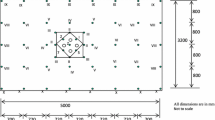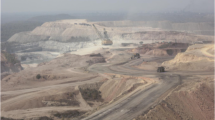Abstract
Blasting is the most common and economical way to excavate rockmass. However, it is associated with unwanted damages to the surrounding rockmass beyond the desired excavation zone, which is called blast-induced rockmass damages. These damages reduce rockmass integrity and pose a problem in drilling, slope failure, improper reduction in bench width, etc. Thus, blast-induced rock damage plays a vital role in ground control at the surface and subsurface excavation. Knowing the extent of rock damage due to blasting can make the excavation site safer and more productive. The techniques associated with measuring the damages are varied according to the physical ground conditions. In the surface blasting, the blast-induced damages are identified by the visual observation and it is measured by the offset surveying method. However, the early detection of blast-induced damage is beneficial for the proper planning of blast design. Scientists have tried to predict the blast-induced rockmass damage through various theory. The available models proposed by various scientists are based on vibration theory, geophysical estimation, soft computing methods, and finite element method. Among them, accessible, less computational, and more accurate method is vibration-based blast-induced damage prediction model. The threshold level of PPV for rock damage is the PPV level at the boundary of the damaged zone. It is defined as the minimum level of PPV at which the rock is damaged. Considering the threshold limit of PPV, various scientists have predicted the extent of the blast-induced damage zone. This paper highlights the construction of established 3D nearfield vibration model for the single charge column. The significance of this model is that it can estimate the PPV in any direction and in a 3D space. The model is tested by conducting experimental blasts in the field. The blast-induced rock damage extents are observed for each blast. The threshold level of PPV for rock damage at the boundary of the damage zones is estimated from the developed nearfield vibration model. Considering the threshold level of PPV for rock damage, damage envelops are created and the accuracy of the delineated damage zones is determined. As these models are site-specific, for determining the damage zone through these models, the site-specific constants are determined. These constants are obtained from the regression analysis between the measured peak particle velocity, ‘v’ (mm/sec) and the square root scale distance ‘SD’ of that site. The result obtained from the test blasts clearly shows that the damage envelops obtained from the threshold level of PPV estimated using developed nearfield vibration model is providing the blast-induced damaged zone for single charge column with sufficient accuracy with a deviation of less than 12 percent.





Similar content being viewed by others
References
K. Dey, J. Bhattacharya, Operation of surface miner: retrospect of a decade journey in India. Procedia Eng. 46, 97–104 (2012). https://doi.org/10.1016/j.proeng.2012.09.451
K. Dey, V.M.S.R. Murthy, Determining blast damage envelope through vibration model and validation using seismic imaging. Min. Technol. 120(2), 90–94 (2011). https://doi.org/10.1179/1743286311Y.0000000004
K. Dey, Investigation of blast induced rock damage and development of predictive models in horizontal drivages [PhD]. IIT (ISM) Dhanbad (2004)
S. Bhandari, Engineering Rock Blasting Operations (Taylor & Francis, Routledge, 1997)
R.N. Gupta, P. Pal Roy, B. Singh, Prediction of peak particle velocity and peak air pressure generated by buried explosion. Int. J. Min. Geol. Eng. 6(1), 15–26 (1988). https://doi.org/10.1007/BF00881024
R.N. Gupta, M.M. Singh, R.S. Singh, An approach to the design of optimum production blast pattern from a single hole blast results. J. Mines Met. Fuels 34(11), 506–510 (1986)
V.M.S.R. Murthy, K. Dey, Predicting overbreak from blast vibration monitoring in a lake tap tunnel–a success story. Taylor Francis Group 7(3), 149–166 (2003)
L.L. Oriard, Blasting effects and their control. In Underground mining methods handbook (SME/AIME ), pp. 1590–1603 (1982)
R. Holmberg, P.A. Persso, The Swedish approach to contour blasting. in Proceedings of Fourth International Conference on Explosive and Blasting Techniques. SveDeFo, pp. 113–127 (1979)
D. Blair, A. Minchinton, On the damage zone surrounding a single blasthole. Fragblast 1(1), 59–72 (1997). https://doi.org/10.1080/13855149709408390
W. Hustrulid, W. Lu, Some general design concepts regarding the control of blast-induced damage during rock slope excavation. in Proceedings of the 7th International Symposium on Rock Fragmentation by Blasting, Beijing, China, 11–15 Aug 2002, pp. 595–604
S. Arora, K. Dey, Estimation of near-field peak particle velocity: a mathematical model. J. Geol. Mining Res. 2(4), 68–73 (2010)
Edwards AT, Northwood TD, Experimental studies of the effects of blasting on structures. The Engineer, 538–546 (1960)
U. Langefors, B. Kihlstrom, The Modern Technique of Rock Blasting (Wiley, 1973)
A. Bauer, P.N. Calder, Open Pit and Blasting (Queen’s University, Kingston, 1970)
T. Meyer, P.G. Dunn, Fragmentation and rockmass damage assessment Sunbrust excavator and drill and blast. North American Rock Mechanics Symposium, 609–616 1995
I. Bogdanoff, Vibration measurement in the damage zone in tunnel blasting. 177–185 (1996)
R.L. Yang, P. Rocque, P. Katsabanis, W.F. Bawden, Measurement and analysis of near-field blast vibration and damage. Geotech. Geol. Eng. 12(3), 169–182 (1994). https://doi.org/10.1007/BF00426985
P.-A. Persson, The relationship between strain energy, rock damage, fragmentation, and throw in rock blasting. Fragblast 1(1), 99–110 (1997). https://doi.org/10.1080/13855149709408392
Funding
There was no funding for this paper. This is an original Ph.D research work.
Author information
Authors and Affiliations
Corresponding author
Ethics declarations
Conflict of interest
The authors declare that they have no conflict of interest.
Additional information
Publisher's Note
Springer Nature remains neutral with regard to jurisdictional claims in published maps and institutional affiliations.
Rights and permissions
About this article
Cite this article
Behera, S., Dey, K. A PPV-Based Prediction Model to Construct Damage Envelop for Crater Blasts. J. Inst. Eng. India Ser. D 103, 13–23 (2022). https://doi.org/10.1007/s40033-021-00294-x
Received:
Accepted:
Published:
Issue Date:
DOI: https://doi.org/10.1007/s40033-021-00294-x




